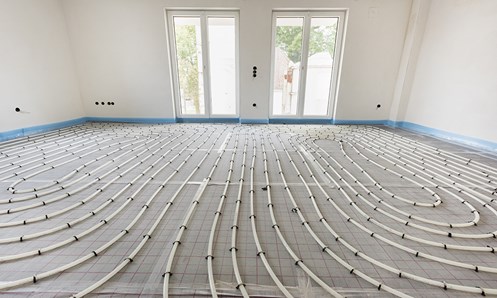
Pro’s and Con’s of underfloor heating
Published by : Deanne on 04 April 2022
Underfloor heating is a growing trend that is often a first choice for homeowners to heat their homes when installing a new bathroom or flooring somewhere else in the home.
Using radiant heat technology, Underfloor Heating gently warms the floor directly, from the ground up – which in the long run could be a more energy-efficient method. As it is hidden and can get rid of dated radiators, it is often seen as a modern luxury item to have within the home which can free up wall space. It’s worth knowing that there are two types of underfloor heating to consider – electric (dry) or water (wet). This article should give you a better idea as to which system will suit your home.
Electric underfloor heating
Electric underfloor heating uses a series of wires or electric heating mats to heat the room. They are usually fitted below or within the flooring.
Water based heating
A water based underfloor heating system is connected to your central heating system. The boiler, heat pump or solar water heating system will heat the water before it travels through the underfloor pipes to heat the room.
Insulation is then used to stop heat escaping downwards into the ground. This will ensure that all of the heat travels up into the room that you are warming up.
Pro’s and Con’s
Let’s take a look at some pro’s and con’s of the heating systems to help you make an informed decision as to whether you will be wanting to have underfloor heating within your home.
Advantages:
• Your room will be evenly heated, as the heat travels upwards from floor to ceiling, the whole room will feel the heat.
• It can heat a larger area than radiators (heating system size dependant)
• It will free up wall space
• Removing radiators can free up a sizeable amount of space, allowing you to utilise more of the room.
• Lower temperatures are needed compared to radiators which need to be really warm to heat up a room.
• Running at a lower temperature, you could see a saving on your heating bills by having a water-based heating system. Dry heating systems run on electricity which will be a more expensive fuel for heating but will still run at a lower temperature than radiators.
• Maintenance free (regular servicing not required for dry heating systems)
• Radiators need bleeding every now and then whereas underfloor heating is pretty much maintenance free.
• If you opt for a water-based heating system you will need servicing from time to time
• Underfloor heating works with different types of flooring (results will differ depending on flooring used)
• Better for your health due to no cold spots
• Underfloor heating will give your home a sense of luxury
Underfloor heating has many benefits for your home, but let’s have a look at some potential disadvantages as well.
Disadvantages
• Initial outlay of costs to install your chosen heating system
• Unless you're having work done on your floors, at the time of installation then it could prove more costly.
• If it is installed whilst you’re having an extension fitted or are moving into a new build, then it will be more straight forward to fit
• If turned on after being off, it will take a longer time to heat up
• Due to the lower operating temperatures, it will take longer to heat the room from the bottom to the top
• You will be restricted with where your furniture can go
• If you are using the electric heating system, furniture that's flat across the bottom will not be able to cover an area of floor where the heating mat or cable is located.
• Restricted airflow if under furniture which can lead to thermal blocking. You will also need to be aware of items that have a tog value over 2.5 such as rugs or bean bags.
• Electricity is more expensive as a fuel – much higher than a water-based system. Bear in mind that an electrician will need to hook the system up to your electricity supply, which could lead to increased installation costs.
Before considering the overall cost of having the heating system installed, you will want to take into account a few things:
• The type of system that you would like to have installed; a water-based or electric system?
• Which rooms would like to have the heating system installed and the size of the rooms?
• Will you be needing any radiators to be removed?
• Do the floors need any work done on them prior to the time of installation?
Once you have considered what you would like you can contact us and we would be more than happy to discuss the details with you.